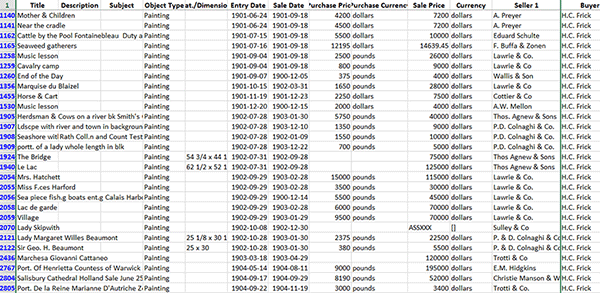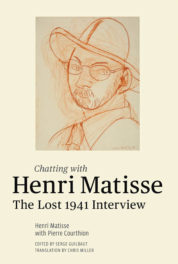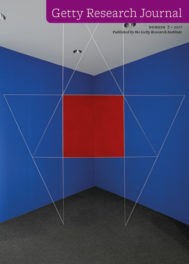In September 2014, the Getty Research Institute launched an expanded dealer stock book database, providing access to stock books 1 through 6 of the Knoedler Gallery, covering 1872 to 1920. The editors of the Project for the Study of Collecting and Provenance (PSCP) are happy to share that the second half of the Knoedler stock books—numbers 7 through 11, covering 1921 to 1970—are now available online.
This addition brings over 16,000 new records to the database, added to the more than 23,000 Knoedler records from the earlier period plus over 43,000 records from the stock books of Goupil & Cie.
A Time of Change
Stock books 7 through 11 reveal a time of great change for the Knoedler Gallery. In these books, sales of artworks by modern masters such as Pablo Picasso, Georges Braque, and Amedeo Modigliani start to appear, first sparsely then profusely. These artists eventually cover the pages, displacing earlier favorites such as Henri Harpignies and Anton Mauve.



Scans of Knoedler stock book pages noting the first sales of paintings by Picasso (May 1927), Braque (April 27, 1927), and Modigliani (March 26, 1929). The Getty Research Institute, 2012.M.54
During the late 1950s and early 1960s, there was also a shift in the volume of painting to sculpture sales. Contemporary sculpture became especially popular, with many sales of artworks by Henry Moore, Étienne Hajdú, and Lynn Chadwick.
While the earlier Knoedler stock books are filled with references to buyers like Henry Clay Frick, the Astor family, and others collectors known for their turn-of-the-century riches, the later books reflect a more diverse art market. The Rockefellers and Guggenheims continued to purchase art, but a few smaller yet notable art collectors also stand out. One entry records a sale by “Wing Commander Roald Dahl,” at 630 5th Avenue; the famed author sold a landscape painting by Henri Matisse to Knoedler in October of 1945.

Scan of a Knoedler stock book indicating a sale by Roald Dahl. The Getty Research Institute, 2012.M.54
Data Metamorphosis
The process of completing this part of the database was a lengthy and complex one. PSCP editors carefully read each entry, deciphering and transcribing the script of the various Knoedler bookkeepers, assigning classification values (such as genre or subject category), and entering the information into spreadsheets, which became the basis for the online database.
Furthermore, PSPC editors enhanced the data by validating the names of buyers, sellers, and artists against a behind-the-scenes authority database that connects distinct entities to their name variants. This process ensures that all of the entries for “James Speyer”—whether his name is written as “Jas. Speyer,” “J. Speyer,” or “James Speyer”—all refer to the same person, the philanthropist and banker James Speyer.

During the transcription process, information from the original handwritten record (top) is input in a spreadsheet (middle), which becomes an entry in the online dealer stock book database (bottom).
With the release of the full Knoedler database, scholars can search and engage with the information in a way that would not be possible with only digitized copies of the stock book pages. With over 40,000 Knoedler entries online, the opportunities for data analysis and digital humanities projects are endless.
An Example of Visualizing Data
A multidisciplinary team of Getty Graduate Interns created Knoedler Unbound, a site that combines art-historical scholarship with technology to uncover insights hidden within the Knoedler stock books. The team used data visualization tools such as such as Gephi and Palladio to generate diagrams of the structured data that guided their research.

Relationship graph displaying the nationality of the artists whose work was purchased by Henry Clay Frick.
Using data from the first six stock books, this graph shows the nationality of artists whose work was purchased by Henry Clay Frick and who was selling them. The graduate intern team first searched the database for artworks purchased by Frick, which yielded 173 results, then used Palladio to visualize the nationalities of artists in relation to the dealers who sold the works.
The sellers are indicated by dark grey circles, while with the artists’ nationalities are represented by lighter grey circles. The size of the node corresponds to the quantity of artworks sold. Not surprisingly, French dealers such as Durand-Ruel, Seligmann, and Georges Petit are clustered around the French nationality node, i.e., they sold works by French artists to Frick.
But there are some surprises. Duveen, another well-known international dealer, is not normally associated with American art, yet they are clearly linked to the sale of an American painting. Upon further research, the team discovered the source of this anomaly: Duveen sold Gilbert Stuart’s portrait of George Washington (1795-96) to Frick in 1918, and the painting is now part of the Frick Collection in New York.
As the graph illustrates, data visualizations can both highlight and challenge traditional narratives about art sales. Relationship graphs allow researchers to see the macro and the micro, revealing insights that might not be noticeable in a list of data. The raw data, as seen in the spreadsheet below, is simply too large and unwieldy to analyze without visualization programs.

Raw data listed in a spreadsheet
The graduate interns’ visualization of information from the Knoedler records is just one example of how the Dealer Stock Books database can be used for research and exploration. The Getty Research Institute provenance team encourages scholars, students, and art enthusiasts to dive into this material and let us know what you find!




Hello,
Thank you for sharing this information about PALLADIO. I applied the tool to a dataset of 80 Italian artists ‘Creators’ and their 171 ‘Imitators’ in 8 European countries. See my post of November 20, 2015: ‘From Spreadsheet to Network Analysis of Art Historical Data, Part II: Visualizing with PALLADIO and measuring connectivity and dispersion’
http://kbender.blogspot.be/2015/11/from-spreadsheet-to-network-analysis-of.html
Regards,
K. Bender
independent researcher